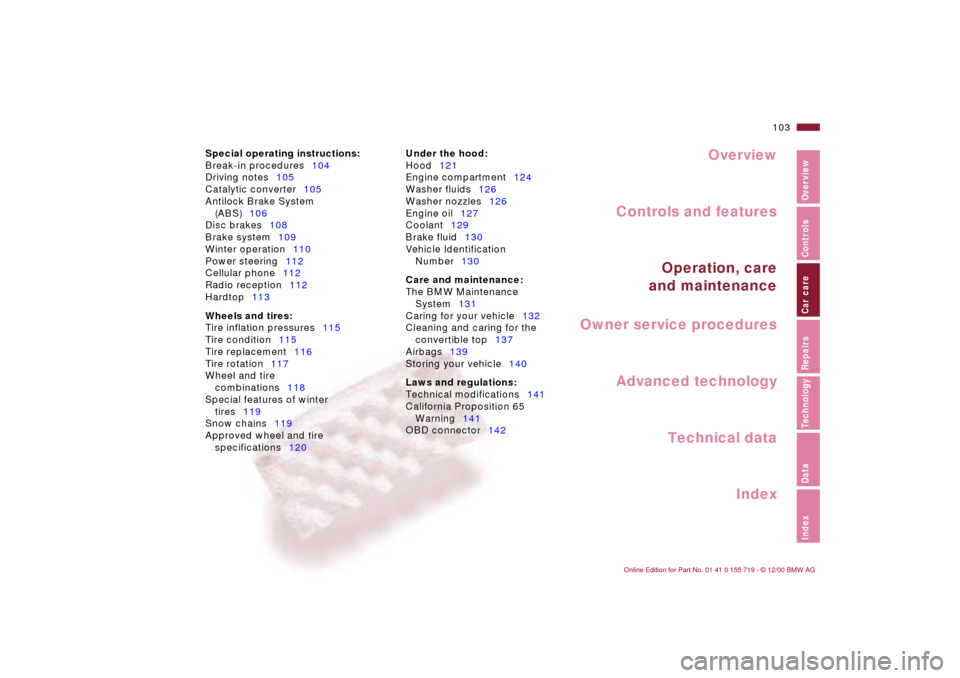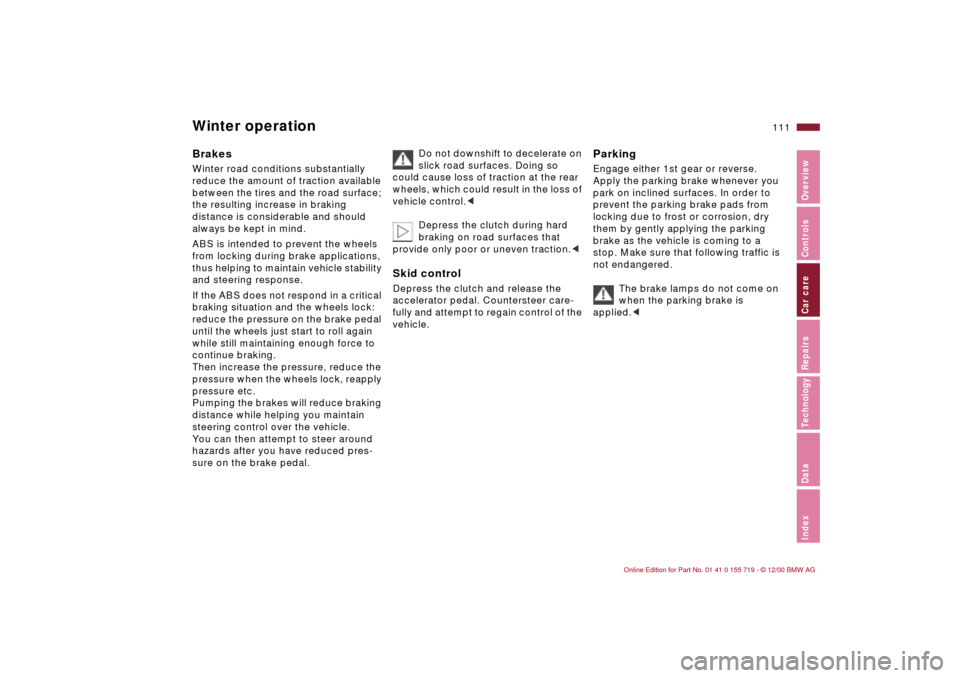winter tires BMW M3 CONVERTIBLE 2001 E46 Owner's Manual
[x] Cancel search | Manufacturer: BMW, Model Year: 2001, Model line: M3 CONVERTIBLE, Model: BMW M3 CONVERTIBLE 2001 E46Pages: 195, PDF Size: 1.96 MB
Page 11 of 195

11n
Controls and features
Operation, care and maintenance
Lamps:
Side lamps/Low beam
headlamps84
Instrument lighting84
High beams/Parking lamps85
Fog lamps85
Interior lamps86
Reading lamps86
Controlling the climate
for pleasant driving:
Automatic climate control88
Heated seats93
Interior conveniences:
Glove compartment94
Storage compartments95
Cellular phone96
Ashtray, front96
Cigarette lighter97
Ashtray, rear97
Loading and transporting:
Ski bag98
Cargo loading100
Roof-mounted luggage rack for
the hardtop101
Special operating instructions:
Break-in procedures104
Driving notes105
Catalytic converter105
Antilock Brake System
(ABS)106
Disc brakes108
Brake system109
Winter operation110
Power steering112
Cellular phone112
Radio reception112
Hardtop113
Wheels and tires:
Tire inflation pressures115
Tire condition115
Tire replacement116
Tire rotation117
Wheel and tire
combinations118
Special features of winter
tires119
Snow chains119
Approved wheel and tire
specifications120
Under the hood:
Hood121
Engine compartment124
Washer fluids126
Washer nozzles126
Engine oil127
Coolant129
Brake fluid130
Vehicle Identification130
Care and maintenance:
The BMW Maintenance
System131
Caring for your vehicle132
Cleaning and caring for the
convertible top137
Airbags139
Storing your vehicle140
Laws and regulations:
Technical modifications141
California Proposition 65
Warning141
OBD connector142
Page 103 of 195

Overview
Controls and features
Operation, care
and maintenance
Owner service procedures
Technical data
Index Advanced technology
103n
IndexDataTechnologyRepairsCar careControlsOverview
Special operating instructions:
Break-in procedures104
Driving notes105
Catalytic converter105
Antilock Brake System
(ABS)106
Disc brakes108
Brake system109
Winter operation110
Power steering112
Cellular phone112
Radio reception112
Hardtop113
Wheels and tires:
Tire inflation pressures115
Tire condition115
Tire replacement116
Tire rotation117
Wheel and tire
combinations118
Special features of winter
tires119
Snow chains119
Approved wheel and tire
specifications120Under the hood:
Hood121
Engine compartment124
Washer fluids126
Washer nozzles126
Engine oil127
Coolant129
Brake fluid130
Vehicle Identification
Number130
Care and maintenance:
The BMW Maintenance
System131
Caring for your vehicle132
Cleaning and caring for the
convertible top137
Airbags139
Storing your vehicle140
Laws and regulations:
Technical modifications141
California Proposition 65
Warning141
OBD connector142
Car care
Page 110 of 195

110n
Winter operationThe onset of winter is often accompa-
nied by rapid changes in weather.
Adaptations in driving style should be
accompanied by preparations on the
vehicle itself to ensure that your
progress through the winter remains
safe and trouble-free. CoolantBe sure that the coolant mixture
contains the year-round ratio of 50:50
water and extended-duty antifreeze/
corrosion inhibitor. This mixture
provides protection against freezing
down to approx. –34 7 (–37 6). Have
the coolant replaced every 3 years. LocksBMW door lock deicer can be used to
free them if frozen. This deicer also
contains lubricant.
After using the deicer, treatment with
BMW lock cylinder grease is recom-
mended.
Rubber components To prevent the weather-stripping from
freezing, apply a spray-on rubber treat-
ment or silicone spray to the door, hood
and luggage compartment lid seals.
A full range of car care products is
available from your BMW center.<
Snow chains Mount BMW snow chains
* only in pairs
on rear tires and always follow the
manufacturer's safety precautions. Do
not exceed a maximum speed of
30 mph (50 km/h) with snow chains. In
rare situations like these, it may be a
good idea to turn the DSC off briefly,
refer to page 80.
Deactivate the Tire Pressure Warning
system (RDW) when driving with snow
chains mounted. Snow chains can
cause the system to generate false
alarms and/or fail to detect pressure
loss, refer to page 81
Starting offWhen trying to drive out of deep snow,
or when "rocking" the vehicle to free it,
it may be prudent to temporarily deacti-
vate the DSC system. Refer to page 80. Driving on low-traction road
surfacesUse smooth, gentle pressure to control
the accelerator pedal. Avoid excessive
engine speeds and shift to the next
higher gear at an early point. Adapt
your speed and driving style when
approaching grades or slopes. Maintain
an adequate distance between yourself
and the vehicle ahead.
Page 111 of 195

111n
IndexDataTechnologyRepairsCar careControlsOverview
Winter operationBrakesWinter road conditions substantially
reduce the amount of traction available
between the tires and the road surface;
the resulting increase in braking
distance is considerable and should
always be kept in mind.
ABS is intended to prevent the wheels
from locking during brake applications,
thus helping to maintain vehicle stability
and steering response.
If the ABS does not respond in a critical
braking situation and the wheels lock:
reduce the pressure on the brake pedal
until the wheels just start to roll again
while still maintaining enough force to
continue braking.
Then increase the pressure, reduce the
pressure when the wheels lock, reapply
pressure etc.
Pumping the brakes will reduce braking
distance while helping you maintain
steering control over the vehicle.
You can then attempt to steer around
hazards after you have reduced pres-
sure on the brake pedal. Do not downshift to decelerate on
slick road surfaces. Doing so
could cause loss of traction at the rear
wheels, which could result in the loss of
vehicle control.<
Depress the clutch during hard
braking on road surfaces that
provide only poor or uneven traction.<
Skid control Depress the clutch and release the
accelerator pedal. Countersteer care-
fully and attempt to regain control of the
vehicle.
ParkingEngage either 1st gear or reverse.
Apply the parking brake whenever you
park on inclined surfaces. In order to
prevent the parking brake pads from
locking due to frost or corrosion, dry
them by gently applying the parking
brake as the vehicle is coming to a
stop. Make sure that following traffic is
not endangered.
The brake lamps do not come on
when the parking brake is
applied.<
Page 117 of 195

117n
IndexDataTechnologyRepairsCar careControlsOverview
Tire replacement Tire rotation
Do not use retreaded tires. Driving
safety may be impaired by their
use. The reason for this are possible
variations in tire casing structures and,
in part, because they are already quite
old, which can lead to a deterioration in
their durability.<
Tire ageThe date on which the tire was manu-
factured is indicated by the code on the
sidewall:
DOT ... 1101 means that the tire was
produced in the 11th week of the year
2001.
BMW recommends replacing all tires
after 6 years at the latest, even if a tire
life of 10 years is possible.
Spare tires over 6 years old should be
used only in case of emergency. A tire
in this condition should be replaced by
a new tire immediately, and should not
be mounted together with new tires.
Re-initialize the Tire Pressure Warning
(RDW) after rotating the tires. Refer to
page 81 for further information.Summer tires
Due to different tire sizes on the
front and rear axles (refer to
page 120), the tires may not be rotated
from one axle to the other.<
Winter tiresThe wheels are designed specifically
for use at the front or rear only.
Because the front and rear wheels
feature different rim depths (refer to
page 120), you should never attempt to
switch wheels from the front to rear or
vice versa.
Page 118 of 195

118n
Wheel and tire combinations The right choice
Only use wheels and tires that
have been approved by BMW for
the corresponding vehicle model, as
otherwise body contact and serious
accidents can result despite the use of
the same nominal size, e.g. due to
tolerances. BMW cannot evaluate non-
approved wheels and tires to determine
if they are suited for use, and therefore
cannot ensure the operating safety of
the vehicle if they are installed.<
For wheel and tire sizes approved by
BMW, refer to page 120.
Failure to use the specified wheel
and tire combinatons can have an
adverse effect on the performance of
various systems such as ABS and DSC.
For this reason, use only tires made by
the same manufacturer and that have
the same tread configuration on the
vehicle. And after a flat tire, for
instance, restore the approved wheel
and tire combination as soon as
possible.<
Codes on the tires and wheels The marking on the tire has the
following meaning.
The codes on radial tires:
The speed rating indicates the
approved maximum speed for the tire.
Summer tires:
S = up to 112 mph (180 km/h)
T = up to 118 mph (190 km/h)
H = up to 130 mph (210 km/h)
V = up to 150 mph (240 km/h)
W = up to 167 mph (270 km/h)
Y = up to 187 mph (300 km/h)
ZR = over 150 mph (240 km/h) Example:
Nominal width
in mm
Aspect
ratio in %
Radial tire ID code
Rim diameter in inches
Load rating
(not on ZR tires)
Speed rating
(before R on ZR tires)
225/45 R
1892W
Winter tires:
Q M+S = up to 100 mph (160 km/h)
T M+S = up to 118 mph (190 km/h)
H M+S = up to 130 mph (210 km/h)
Codes stamped on light-alloy wheels:
Protect tire valve from dirt by using
screw-on valve stem caps. Dirt in the
valves frequently leads to slow leaks. Storage Always store tires in a cool, dry place.
Store them away from light whenever
possible. Protect the tires against
contact with oil, grease and fuel. Example:
Rim width
in inches
Code letter for
flange type
Symbol for full-drop
center rim
Rim diameter in inches
Hump on the 2 rim shoulders
8 x 18 H 2
J
Page 119 of 195

119n
IndexDataTechnologyRepairsCar careControlsOverview
Use narrow-link BMW snow chains on
winter tires in pairs only and only on the
rear wheels. Comply with all manufac-
turer's safety precautions when
mounting the chains.
Deactivate the Tire Pressure
Warning system (RDW) when
using snow chains. Malfunction warn-
ings and undetected losses in pressure
are a possibility when driving with snow
chains.
For further information, refer to
page 81.<
Tire condition, tire pressureOnce winter tires wear to a tread depth
of less than 0.16 in (4 mm), their perfor-
mance under winter driving conditions
deteriorates noticeably. Worn tires
should therefore be replaced to ensure
continued safety.
Inflate tires to specified pressure and
have the wheels balanced every time
the tires or wheels have been rotated;
re-initialize the Tire Pressure Warning
system (RDW) as well. Refer to page 81
for further information.
Special features of winter tires Snow chains
*
Choosing the right tireBMW recommends winter tires (M+S
radial tires) for driving in adverse winter
road conditions. So-called all-season
tires with the M+S identification mark
do indeed possess better winter trac-
tion than summer tires that have the H,
V, W, Y and ZR speed ratings, but they
generally fail to provide the same levels
of performance as winter tires.
In the interest of safe tracking and
steering response, install winter tires
made by the same manufacturer with
the same tread configuration on all four
wheels. Do not exceed specified
maximum speeds
Never exceed the maximum
speed for which the tires are
rated.
Unprofessional attempts by laymen to
service tires can lead to damage and
accidents.
Have this work performed by skilled
professionals only. Any BMW center
has the required technical knowledge
and the proper equipment and will be
happy to assist you.<
Page 120 of 195

120n
Approved wheel and tire specifications Depending on the tire size, certain tire brands tested by BMW have been
classified and approved as safe in traffic. Contact your BMW center for a list
of these tires.
Observe any country-specific regulations, e.g. on making a corresponding
entry in the vehicle documents.
Tire specifications Light-alloy wheel
BMW M3 convertible
Summer tires
Front: 225/45 ZR 18 8J x 18 EH2
Rear: 255/40 ZR 18 9J x 18 EH2
Front: 225/40 ZR 19 8J x 19 EH2
Rear: 255/35 ZR 19 9.5J x 19 EH2
Winter tires (M+S)
Front: 225/45 R 17 91 H
Rear: 225/45 R 17 91 H7.5J x 17 EH2 IS47
7.5J x 17 EH2 IS25
Snow chains
*
It is not possible to mount snow chains
on tires with 18-/19-inch wheels.
Deactivate the Tire Pressure
Warning system (RDW) when
using snow chains. Malfunction warn-
ings and undetected losses in pressure
are a possibility when driving with snow
chains.
For further information, refer to
page 81.
always remember the different rim
depths on the front and rear wheels.
Failure to mount the tires approved for
each wheel can lead to damage.<
Page 132 of 195

132n
Washing your vehicle You can wash your BMW at an auto-
matic car wash, even when it is new.
Car wash systems that do not employ
brushes are preferable.
Wipe away tough dirt and loosen and
remove dead insects before washing
the vehicle.
In order to avoid spots, do not wash the
vehicle when the hood is warm, or
during or immediately after exposure to
strong sunlight.
When using an automatic car wash, be
sure that:
>The car wash system is suited for the
dimensions of your vehicle.
>No damage will occur on vehicles
with attached body accessories (such
as spoilers or antennas). Consult the
car wash operator if necessary.
>The wheels and tires of your vehicle
cannot be damaged by the convey-
ance devices of the car wash system.
>The vehicle is cleaned with minimum
brush pressure, and that plenty of
water is available for washing and
rinsing. Vehicles with rain sensor
*:
Clean the windshield regularly. Wax
from automatic car washes or insects
can cause malfunctions in the rain
sensor
* function.
Turn the rain sensor off (refer to
page 69) when going through an
automatic car wash, otherwise, damage
could occur from unintended wiper
activation.<
Parts of the vehicle that are inacces-
sible to the automatic washer – such as
door sills, door and hood edges, etc. –
should be cleaned by hand.
In the winter months, it is especially
important to be sure that the vehicle is
washed on a regular basis. Large quan-
tities of dirt and road salt are difficult to
remove, and they also damage the
vehicle.
If spray wands or high-pressure
washers are used, be sure to
maintain an adequate distance between
the spray source and the vehicle's
surface. Inadequate distance and
excessive pressure can damage or
weaken the finish, making it more
susceptible to subsequent attack. In
addition, moisture could penetrate to
vehicle components, leading to long-
term damage.<
When cleaning the headlamps,
please observe the following:
>Do not clean by wiping with a dry
cloth (this causes scratches). Never
use abrasives or strong solvents to
clean the covers.
>Remove dirt and contamination (such
as insects) by soaking with BMW Car
Shampoo and then rinsing with plenty
of water.
>Always use a deicer spray to remove
accumulated ice and snow – never
use a scraper.<
After washing the vehicle, apply
the brakes briefly to dry them.
Braking efficiency might otherwise be
reduced by the moisture and the brake
discs could also corrode.<
Caring for your vehicle
Page 190 of 195

Everything from A to ZMicrofilter92
replacing161t
Mirrors52
automatic curb
monitor52
heating52
memory54
outside52
Mobile phones112
Mobility system153
Modifications,
technical6, 141
Mounting the hardtop113
Multifunction steering wheel
(MFL)24NNavigation system, refer to
the separate Owner's
Manual
Nozzles88OOdometer73
Oil
additives127
capacity181
consumption127
dipstick127
filter change181level, indicator
lamp20, 21
pressure, indicator
lamp20
quality128t
specifications128t
viscosity128t
Oil change intervals, refer to
the Service and Warranty
Information Booklet (US
models) or to the Warranty
and Service Guide Booklet
(Canadian models)
OILSERVICE75
Onboard tool kit146t
Opening and closing
from inside38
via the door lock34
via the remote control35
Opening the hood121t
Outlets, ventilation88
Outside mirror52
Outside temperature
display77
PPaint blemishes133
Paint, care133
Paintwork
care133
minor repairs134
waxing134Park Distance Control
(PDC)79
Parking brake67
Parking help79
Parking lamps84, 85
Parking, winter111
PDC (Park Distance
Control)79
Performance178
Pollen from outside air92
Power steering112
Power windows44
Powerplant data178
Pressure, tires115
Prevent any unwanted
alarm43t
RRadiator181
Radio Data System
(RDS)169
Radio reception113, 169
Radio, refer to the separate
Owner's Manual
Rain sensor70, 172
RDS (Radio Data
System)169
RDW (Tire Pressure
Warning)81
Reading lamps86
Rear entry51
aid51Rear fog lamps85
replacing bulb149t
Rear lamps149t
Rear window
defroster71, 92
Rearview mirror52
Recirculated air mode91
Reclining seat48
Refueling26
Remote control35
Removing condensation,
windows91t
Replacement keys32
Replacing bulbs146t
Replacing microfilter and
activated-charcoal
filter161
Replacing windshield wiper
blades146t
Reporting safety defects7
Restraint system58
Returning used
batteries159t
Reverse68
Rollover protection
system64, 175
indicator lamp22
lower64t
Roof load capacity180
Roof-mounted luggage
rack101
Rubber components110